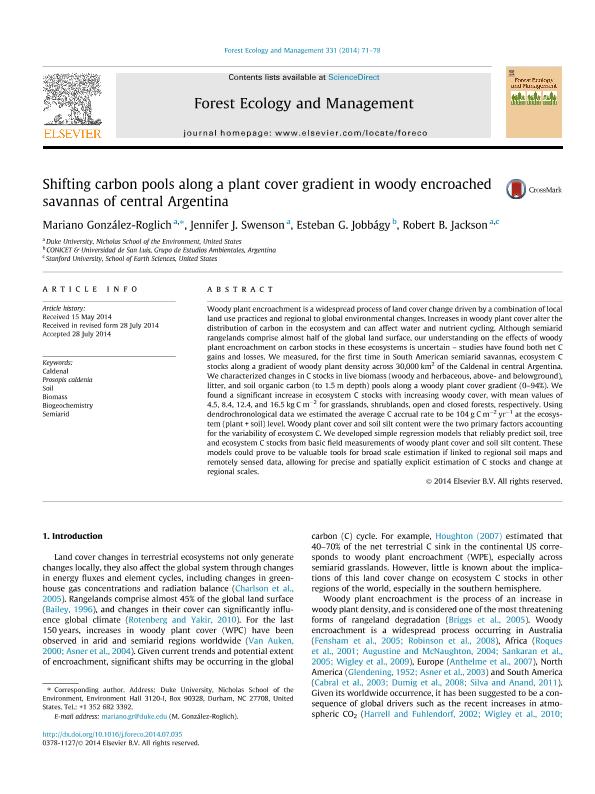Mostrar el registro sencillo del ítem
dc.contributor.author
Gonzalez Roglich, Mariano
dc.contributor.author
Swanson, Jennifer
dc.contributor.author
Jobbagy Gampel, Esteban Gabriel

dc.contributor.author
Jackson, Robert B.
dc.date.available
2017-03-31T20:13:09Z
dc.date.issued
2014-01
dc.identifier.citation
Gonzalez Roglich, Mariano; Swanson, Jennifer; Jobbagy Gampel, Esteban Gabriel; Jackson, Robert B.; Shifting carbon pools along a plant cover gradient in woody encroached
savannas of central Argentina; Elsevier Science; Forest Ecology And Management; 331; 1-2014; 71-78
dc.identifier.issn
0378-1127
dc.identifier.uri
http://hdl.handle.net/11336/14642
dc.description.abstract
Woody plant encroachment is a widespread process of land cover change driven by a combination of local land use practices and regional to global environmental changes. Increases in woody plant cover alter the distribution of carbon in the ecosystem and can affect water and nutrient cycling. Although semiarid rangelands comprise almost half of the global land surface, our understanding on the effects of woody plant encroachment on carbon stocks in these ecosystems is uncertain ? studies have found both net C gains and losses. We measured, for the first time in South American semiarid savannas, ecosystem C stocks along a gradient of woody plant density across 30,000 km2 of the Caldenal in central Argentina. We characterized changes in C stocks in live biomass (woody and herbaceous, above- and belowground), litter, and soil organic carbon (to 1.5 m depth) pools along a woody plant cover gradient (0?94%). We found a significant increase in ecosystem C stocks with increasing woody cover, with mean values of 4.5, 8.4, 12.4, and 16.5 kg C m-2 for grasslands, shrublands, open and closed forests, respectively. Using dendrochronological data we estimated the average C accrual rate to be 104 g C m-2 yr-1 at the ecosystem (plant + soil) level. Woody plant cover and soil silt content were the two primary factors accounting for the variability of ecosystem C. We developed simple regression models that reliably predict soil, tree and ecosystem C stocks from basic field measurements of woody plant cover and soil silt content. These models could prove to be valuable tools for broad scale estimation if linked to regional soil maps and remotely sensed data, allowing for precise and spatially explicit estimation of C stocks and change at regional scales.
dc.format
application/pdf
dc.language.iso
eng
dc.publisher
Elsevier Science

dc.rights
info:eu-repo/semantics/openAccess
dc.rights.uri
https://creativecommons.org/licenses/by-nc-nd/2.5/ar/
dc.subject
Caldenal Soil
dc.subject
Prosopis Caldenia
dc.subject
Biomass
dc.subject
Biogeochemistry
dc.subject.classification
Ecología

dc.subject.classification
Ciencias Biológicas

dc.subject.classification
CIENCIAS NATURALES Y EXACTAS

dc.title
Shifting carbon pools along a plant cover gradient in woody encroached
savannas of central Argentina
dc.type
info:eu-repo/semantics/article
dc.type
info:ar-repo/semantics/artículo
dc.type
info:eu-repo/semantics/publishedVersion
dc.date.updated
2017-03-31T18:13:44Z
dc.journal.volume
331
dc.journal.pagination
71-78
dc.journal.pais
Países Bajos

dc.journal.ciudad
Amsterdam
dc.description.fil
Fil: Gonzalez Roglich, Mariano. University Of Duke; Estados Unidos
dc.description.fil
Fil: Swanson, Jennifer. University Of Duke; Estados Unidos
dc.description.fil
Fil: Jobbagy Gampel, Esteban Gabriel. Universidad Nacional de San Luis; Argentina. Consejo Nacional de Investigaciones Científicas y Técnicas. Centro Científico Tecnológico San Luis. Instituto de Matemática Aplicada de San Luis; Argentina
dc.description.fil
Fil: Jackson, Robert B.. University Of Stanford; Estados Unidos
dc.journal.title
Forest Ecology And Management

dc.relation.alternativeid
info:eu-repo/semantics/altIdentifier/url/http://www.sciencedirect.com/science/article/pii/S0378112714004782
dc.relation.alternativeid
info:eu-repo/semantics/altIdentifier/doi/http://dx.doi.org/10.1016/j.foreco.2014.07.035
Archivos asociados
